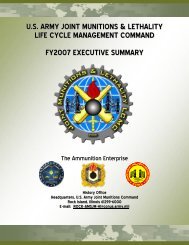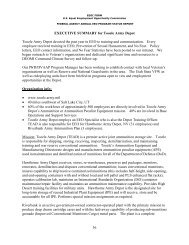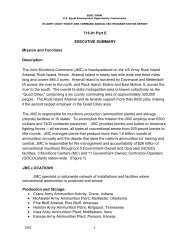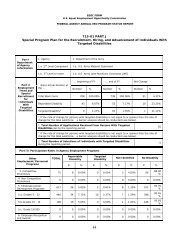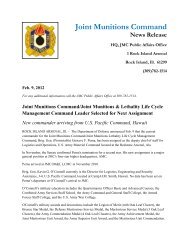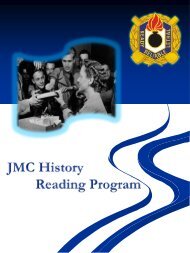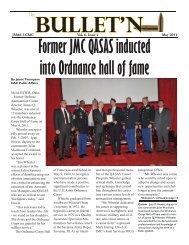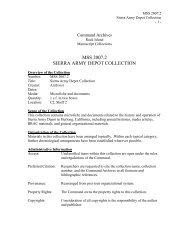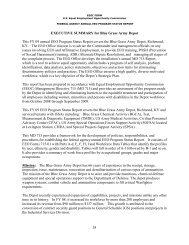History of the Ammunition Industrial Base - JMC - U.S. Army
History of the Ammunition Industrial Base - JMC - U.S. Army
History of the Ammunition Industrial Base - JMC - U.S. Army
Create successful ePaper yourself
Turn your PDF publications into a flip-book with our unique Google optimized e-Paper software.
for <strong>the</strong> GOCO inactive plants to gain full production; and over two years for producers to meet<br />
total requirements. 66<br />
In January 1965, <strong>the</strong> War Reserve was significantly less than what was authorized. The<br />
figures cited above were authorized in DoD Logistics Guidance for 1966, published in <strong>the</strong> fall <strong>of</strong><br />
1964. However, due to budget limitations, ammunition procurement would not attain <strong>the</strong> sixmonth<br />
and D-P levels until January 1969. The <strong>Army</strong> did not buy 100% <strong>of</strong> <strong>the</strong> requirement for<br />
each year. For FY 1966 <strong>the</strong> <strong>Army</strong> purchased only 54% <strong>of</strong> <strong>the</strong> <strong>Army</strong> Pacific requirements. The<br />
FY1966 buys were budgeted prior to <strong>the</strong> outbreak <strong>of</strong> hostilities when action in Vietnam was not<br />
anticipated. 67<br />
<strong>Base</strong>d on 1964 guidance from <strong>the</strong> Secretary <strong>of</strong> Defense, service stockpile levels appeared<br />
to be in good shape for 1965; however, this was a false appearance. 68 Hostilities soon revealed<br />
significant readiness issues. The first issue was that a large percentage <strong>of</strong> <strong>the</strong> stockpile was left<br />
over WWII and Korean War stocks. Many <strong>of</strong> <strong>the</strong>se items were obsolete, unserviceable, or<br />
substitute items. For <strong>the</strong> decade prior to 1965 very little funding had been expended on<br />
maintenance <strong>of</strong> stockpile items. Despite a lack <strong>of</strong> funding, <strong>the</strong> <strong>Army</strong> assumed that all<br />
serviceable stocks could be returned to serviceable status. While a funded system may have been<br />
able to repair a significant quantity <strong>of</strong> unserviceable stocks, this would take time; and <strong>the</strong>se were<br />
<strong>the</strong> same stocks stored to maintain <strong>the</strong> fighting force until <strong>the</strong> production base could gain full<br />
volume.<br />
In addition to serviceability issues, <strong>the</strong>re were challenges associated with technology<br />
advancement. Many <strong>of</strong> <strong>the</strong> Air Force ammunition items had been produced for WWII and<br />
Korean era vintage aircraft. These rounds were unsuitable for high speed jet aircraft, yet <strong>the</strong>y<br />
were still listed as authorized substitute items for preferred munitions. However, <strong>the</strong> asset<br />
reporting system masked <strong>the</strong> technology and serviceability issues. The stockpile was reported to<br />
DoD in terms <strong>of</strong> tonnage, not readiness. Therefore, if <strong>the</strong> preferred or substitute items were in<br />
<strong>the</strong> stockpile, <strong>the</strong> tons were reported as on hand and ready for use. Details did not show <strong>the</strong><br />
percentage <strong>of</strong> new to old munitions or serviceability by line item. 69 The shortcomings became<br />
apparent immediately after <strong>the</strong> start <strong>of</strong> large scale hostilities.<br />
Despite <strong>the</strong> rapid escalation <strong>of</strong> <strong>the</strong> conflict in Vietnam and glaring issues <strong>of</strong> consumption<br />
versus production, policy impeded <strong>the</strong> reactivation <strong>of</strong> plants and civilian manufacture.<br />
Department <strong>of</strong> Defense policy required Service Secretary and <strong>the</strong>n Defense Secretary approval <strong>of</strong><br />
funds to reactivate plants. The Major Command Commander could approve renovations and<br />
modernization up to $500,000. The Secretary <strong>of</strong> <strong>the</strong> <strong>Army</strong> approved spending for costs between<br />
$.5 and $1 million. Projects in excess <strong>of</strong> $1 million required Secretary <strong>of</strong> Defense approval.<br />
Each request took an average <strong>of</strong> five weeks for approval. 70 In many cases, contractors would not<br />
sign production contracts until <strong>the</strong> renovation requests were approved. This added more delays<br />
resulting in increased production lead times.<br />
66 Besson Board, 28, 31.<br />
67 LTG Joseph Heiser, Jr., Vietnam Studies, Logistics Support (Center <strong>of</strong> Military <strong>History</strong>, DA: 1974), 119.<br />
68 Besson Board. See p. 30 for a table <strong>of</strong> fill rates against objectives for key ammunition items.<br />
69 Besson Board, 28 and 67-68.<br />
70 Ibid, 102-3.<br />
25



